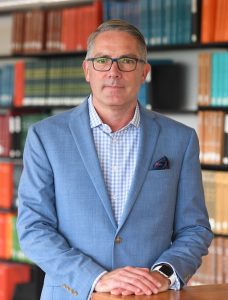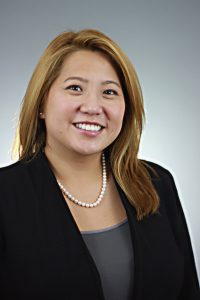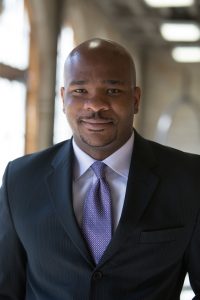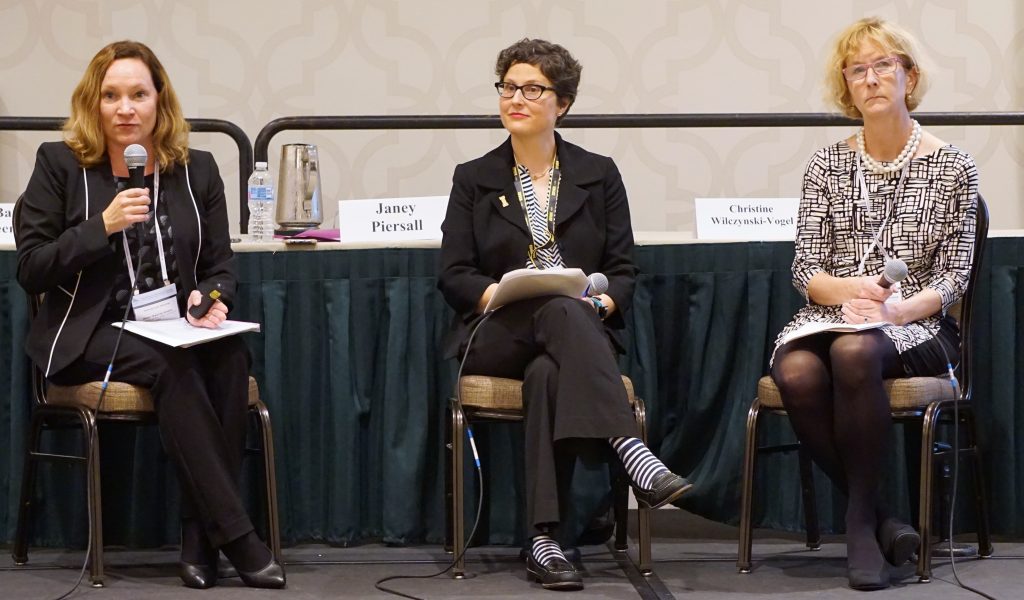By Barbra Elenbaas
The Section on Institutional Advancement provides informational exchange and professional development among law school administrators and faculty involved in those areas of institutional advancement known as alumni relations, communications, development, external affairs, government relations, and public relations.
2018 Co-Chair: Trent Anderson, Assistant Dean for Marketing and Communications, St. John’s University School of Law

Trent Anderson, Photo courtesy of St. John’s University School of Law
2018 Co-Chair: Jini Jasti, Associate Dean for Alumni Relations & External Affairs, University of Wisconsin Law School

Jin Jasti, Photo courtesy of University of Wisconsin Law School
2019 Chair: Darnell Hines, Senior Director of Alumni Engagement and Donor Relations, Northwestern University Pritzker School of Law

Darnell Hines, Photo courtesy of
Northwestern University
Pritzker School of Law
Darnell Hines: We’re comprised of communicators, people on alumni relations, fundraisers—including major gifts officers, annual giving officers, and professionals involved with stewardship. We have some deans, particularly new deans who need to professionalize their shops or need to understand the foundations of institutional advancement.
Trent Anderson: Most law schools have one person wearing multiple hats. There’s a significant minority of people who work on things like JD recruitment or LLM programs as part of their responsibility, with the core things Darnell outlined being their primary responsibilities.
There’s a difference between public and private [law schools], but there’s also a difference between private-standalone schools and private schools affiliated with an undergraduate institution. The size of class also makes a difference. Yale, for example, private-affiliated but small and highly ranked, has a very different set of needs than St. John’s. I’m affiliated with a large undergraduate institution, in a different tier in terms of competitiveness, with a different size of class, attracting different types of LLM students. There is a wide variety.
A great thing about this section is that it pulls together people from diverse situations and gives us all the opportunity to hear how people are doing things differently. People are tackling similar problems in very different ecosystems and environments. I’ll often walk away with ideas that I’d like to try from an institution that looks nothing like ours.
DH: One of the things we are very conscious about [when planning for the Annual Meeting] is making sure that no matter your rank, the size of your institution, or your staff, you will be able to take something away from this conference. I think the networking aspect is one of the more valuable pieces of this conference. You can easily find another shop or institution that is as exact [a match to you] as possible, and for the next two or three years, you can rely on each other. We’re not reinventing wheels here. We’re in this together, sharing what has made us successful because we want you to do the same thing.
Jini Jasti: I serve as the Associate Dean of External Affairs at the University of Wisconsin Law School. I went to UW Law School and then practiced law, but was recruited to come back to relaunch the alumni relations position. Now, I manage the external affairs department: alumni relations, annual fundraising, law school student events—everything from orientation to graduation, all alumni events, and communications including the website, social media, and press relations. I’m from a public school, with a very lean staff—I’m one of those people who wears lots of hats.
DH: My background is in donor relations and stewardship. I am now in charge of our alumni relations office at Northwestern Law.
TA: I have a JD/MBA from University of Southern California and worked in private industry for decades. My official title is marketing and communications. I treat it like the corporate world, and each of the internal stakeholders are clients. I do JD admissions, LLM admissions, fundraising, alumni relations, and student events. I work with career development. I’m a liaison to the university. I do web design—largely what Jini is doing, which is a model that many law schools are finding more efficient.
The whole theme of our program this year was that stewardship is everyone’s job. The law schools that have been the most successful are cross-departmental, cross-functional, intra-university, and achieving a shared goal.
JJ: Institutional fundraising often involves faculty—especially faculty members who run centers or programs and can act as the face of that program. Student stories can illustrate a program’s immediate impact, but it’s nice to highlight a faculty member because they are long-lasting. An important part of successful fundraising is fostering trust in the institution’s leadership, whether that’s the dean and how they’re managing the school or, if you’re dealing with donors who are investing to initiate a program, the people who run them. They need to believe in the people, and that’s often the faculty member.
Whenever it makes sense, we bring faculty to meet with donors. The donors like hearing about faculty passion, their research, their interests, and where they want to take a project. That’s very helpful.
TA: For us, faculty are clients. If someone has been published and wants the world to know about it, we’ll do faculty scholarship updates, or help them organize a faculty workshop series. We’ll work with the alumni relations office to identify the proper subset of alumni to invite them to an event. We have a lot of cross-collaboration with faculty to help support whatever their individual agendas are.
JJ: I think younger faculty hired now do, and senior faculty grow to understand that our alumni come to these events to be reengaged with the school.
I think the smoke and mirrors around development makes people nervous. The idea that if you’re not afraid to ask for money, it means you’re good at asking money, as though there’s a secret language or handshake that they have to learn. But advancement is just engaging with people. I think we need to do better as professionals to spread that word along. I encounter a lot of faculty who want to be prepped and don’t need to be, because they are extremely lovely people. Just have a conversation; that’s all that’s required.
DH: A lot of faculty members, tenured and not, may not be prepared for front-facing roles but may understand the benefits of having them. The more they are out there, the more access donors and alumni have to their scholarship and the work that they are doing. The more access, the greater the potential for private funding.
JJ: Oh yes. Everyone should take media training.
TA: Consistent communication, as well. I’m occasionally (not often) blindsided by a faculty member who’s out doing something either wonderful or controversial. Just let me know in advance! We won’t stop you or tell you what to do. We’ll respect your academic freedom. But we can help support you.
Our goals are to forward the institution. If faculty let us know what they’re doing, we can help manage the situation, not the faculty, for the institution. Faculty are radically different. Some are great with engaging and communicating, and some want to do their own thing.
DH: The strength of our law schools lies in the faculty. Deans come and go. Alumni have a very sentimental connection with a lot of [faculty members]. I think faculty can do a lot, particularly with alumni with whom they have a very close connection and long-standing relationship. To continue to engage them around their practical expertise and bring that into the classroom is something we’ve tried to do at Northwestern for a while, and our faculty were receptive to that.
TA: Very few law schools these days operate solely on tuition. At least a significant minority of the annual expense is from a school’s endowment income and annual giving. The survival of the law school depends on development professionals.
JJ: I’m coming from a state that has decreased support for [higher education] and, as a result, we’ve suffered some budget cuts. I think our faculty are really engaged, intellectual members of our community. They keep coming up with innovative ideas, and they know the best way to make them happen is from outside forces like foundations or alumni. I have seen a shift in our faculty being much more aware and understanding of the work that our development office and dean do. Instead of being behind closed doors where only certain people are in the room, [budgeting has] been more of a building-wide or even institution-wide conversation.
TA: I think that’s true at many law schools. Faculty are much more aware of the mechanics, the organizational structure, and the business of how a law school runs. My impression is that faculty are much more positively involved in understanding the machinations of the academy.
JJ: Related to why faculty should get involved in advancement: if anyone has administrative aspirations to become a dean, a provost, or even president of a university or college, they must have advancement in their wheelhouse. This is a very safe space for them to do it.
“We’re in this together, sharing what has made us successful because we want you to do the same thing.” – Darnell Hines
TA: More intrabuilding cooperation and connecting students, faculty, and alumni. Use of data in all aspects of what we’re doing.
JJ: Ten years ago, social media was used completely differently than it is now. That affects institutions and faculty because they’re involved in highlevel research and dialogue.
TA: The social tool for law faculty now is Twitter. If you don’t have a Twitter account, you’re not communicating with your peers or with the press.
DH: The way in which we tell the story of the work happening at our institutions is also different now, not just the vehicles through which we share the information. I think we have shifted toward more emotion and sentiment. When I started out, I was always taught that lawyers don’t like sentiment. Just the facts. And yet, the way in which we tell the stories—it’s pulling on the heartstrings and being social justice-oriented. It’s not being afraid to be emotional about the work. I see a sea change in communicating.
Another aspect is that law schools are more competitive. We in advancement are very much entwined with the admissions process. Our goal is to raise enough money to attract the kind of students that we want at our institution. We’re fighting over the same students that our peers are fighting over, so we tell stories about why they should attend Northwestern instead of Yale or Harvard. We utilize the profile of our faculty to do that. We have to draw sharp contrasts with other institutions to attract our prospective students.
TA: I received very positive feedback on the sessions and the practicality of the information that people walked away with. The last session on data included specific steps that people could take regardless of their infrastructure. Many schools have nowhere near the resources or access to data that the presenter did, yet she was able to present it in a variety of contexts so that everyone could leave with something to address their highest priority need. I think that is representative of many of our sessions. We also heard a lot of kudos for our first plenary session speaker, Anthony Graves, who was incredibly powerful. We got very lucky this year. I think for any section, starting off with something powerful, positive, and emotional that people can relate to sets the tone for the entire program.
JJ: The diversity of the panelists and the institutions they represent was particularly strong this year. [Striking a balance] is tough because our institutions are diverse. It’s difficult to craft a program that’s attractive and meaningful for all our audiences. I am proud of us, because our panelists represented big schools, small schools, and standalone. People are more likely to attend and like the content if the person in front of them is either inspirational or from people in similarly-situated institutions.
DH: I do think attendees want concrete takeaways, but I don’t think that, as professionals, we should only be doing that. We also need to facilitate interpretive judgment, to lay foundations for the strategy and professionalization of what we do. For those conversations, as an attendee, you have to extrapolate to see what you can take and apply to your institution. My particular point of view is to have a mix of those things, because if every session is “do exactly x, y, and z,” then that sort of fails in what we’re trying to do, which is professional development.
TA: Another part of that professional development is networking. That’s why I got involved in this. I’ve called half a dozen people over the past year because I had a particular issue or problem, or idea or something to bounce off from, and I wouldn’t have known any of them [if not for our section].

An Institutional Advancement session on stewardship. Shari Baurle Green (University of San Diego Law), Janey Piersall (University of Iowa Law), and Christine Wilczynski-Vogel (Marquette University Law).
TA: We have a two-year cycle and are typically led by co-chairs, followed by co-chair-elects and a committee. We have a large planning session in February at AALS headquarters in Washington, DC, with the chairs and people they’ve recruited in different areas—typically a person on alumni relations, one on development work, possibly a major gifts or communications person. We spend the meeting brainstorming with support from AALS, going through what worked and what didn’t in previous years, themes or ideas we’ve heard, survey results, and so on, and we feed all of that into creating an agenda.
At the end of that one day, we emerge with a prototype of an overall theme, topics for plenary and breakout sessions, and assigned responsibilities for each of the people in the room. Inevitably, some people drop out of the planning committee or can’t make it to the meeting as a speaker, and we have to make other plans.
Then, when the conference actually happens, we switch over to the next group and start the process over. Many people tend to stay actively involved for about two years or more.
DH: I have some idea of people I’d like to work with this year, but [committee members are not lined up in advance]. I’ve observed that the committee perhaps needs to be a bit bigger. Not necessarily the core committee, but we could expand it out to share responsibilities. AALS deadlines often run up against busy times in our academic year. The committee is trying to recruit panelists who are in the thick of things just like us and often can’t commit. That piece is a little challenging.
The other piece is helping to bring in new blood so that we have new ideas and different way of doing things. I think this year’s program was particularly good because we had all been on previous iterations of a conference committee. We had collective wisdom and experience. But new blood matters, too.
This is where we may be different from other sections: we’re more about simply putting on a great conference. Our energy is focused there.
DH: There are other conferences. We have a cohort of [the so-called] T14 schools. There are cohorts for alumni relations, annual giving, student services, admissions, and so on outside of AALS. The Big Ten group has a similar thing. These other cohorts meet throughout the year outside of AALS.
TA: There are regional cohorts as well. Like the New York law schools, for example. Some are formal, and some are less formal. But there are always opportunities to meet.
DH: There are also larger events like CASE (Council for Advancement and Support of Education), which is national.
DH: I want to continue to do exactly what we did this year: create a dayand-a-half where people have an opportunity both for professional development and for more practical development in terms of what they do on a day-to-day basis at work, and to provide a number of networking opportunities. I would also like to professionalize and better organize our section to have more of a pipeline of committee members and co-chairs. This is what we do at our shops. We’re building panels, we’re putting on events, we’re doing alumni events around the country.
TA: We all deal with crisis. Nothing throws us. No panelist for a session? Didn’t make their flight? We’ll work it out. This is our wheelhouse.
DH: This is what we do. If our section members are thinking, “I only have a certain amount of money in my budget this year. Do I go to CASE? Do I go to AALS? Do I go to the T14 cohort?” then we want them to come here. This is the destination for the best conference that you can avail yourself of in a year. This year, I want to build a conference that makes people say, “There are so many other opportunities, but the content looks good, the program looks good, the faculty look great, and I’m going to AALS.”